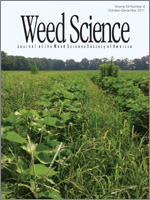Assessing belowground plant interference in rice has been difficult in the past because intertwined weed and crop roots cannot be readily separated. A 13C discrimination method has been developed to assess distribution of intermixed roots of barnyardgrass and rice in field soils, but the suitability of this approach for other rice weeds is not known. 13C depletion levels in roots and leaves of rice were compared with those of 10 troublesome weed species grown in monoculture in the greenhouse or field. Included were C4 tropical grasses: barnyardgrass, bearded sprangletop, Amazon sprangletop, broadleaf signalgrass, fall panicum, and large crabgrass; C4 sedge, yellow nutsedge; and C3 species: red rice, gooseweed, and redstem. Rice root δ13C levels averaged ∼ −28‰, indicating that these roots are highly 13C-depleted. Root δ13C levels ranged from −12‰ to −17‰ among the tropical grasses, and were −10‰ in yellow nutsedge, indicating that these species were less 13C depleted than rice, and were C4 plants suitable for 13C discrimination studies with rice. Among the C4 species, bearded sprangletop and yellow nutsedge were most and least 13C depleted, respectively. δ13C levels in shoot and root tissue of pot-grown plants averaged 6% greater for C4 plants and 9% greater for rice in the field than in the greenhouse. In pots, shoots of rice typically were slightly more 13C depleted than roots. A reverse trend was seen in most C4 species, particularly for broadleaf signalgrass and plants sampled from field plots. Corrections derived from inputs including the total mass, carbon mass, carbon fraction, and δ13C levels of roots and soil increased greatly the accuracy of root mass estimates and increased slightly the accuracy of root δ13C estimates (∼ 0.6 to 0.9%) in samples containing soil. Similar corrective equations were derived for mixtures of rice and C4 weed roots and soil, and are proposed as a labor-saving option in 13C discrimination root studies.
Nomenclature: Barnyardgrass, Echinochloa crus-galli (L.) Beauv.; bearded sprangletop, Leptochloa fusca (L.) Kunth var. fascicularis (Lam.) N. Snow; Amazon sprangletop, Leptochloa panicoides (J. Presl) A. S. Hitchc.; broadleaf signalgrass, Urochloa platyphylla (Nash) R. D. Webster; fall panicum, Panicum dichotomiflorum Michx.; large crabgrass, Digitaria sanguinalis (L.) Scop.; yellow nutsedge, Cyperus esculentus L.; gooseweed, Sphenoclea zeylanica Gaertn.; redstem, Ammannia coccinea Rottb.; red rice, Oryza sativa L.; rice, Oryza sativa L.





